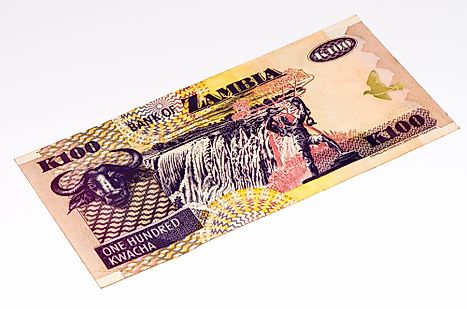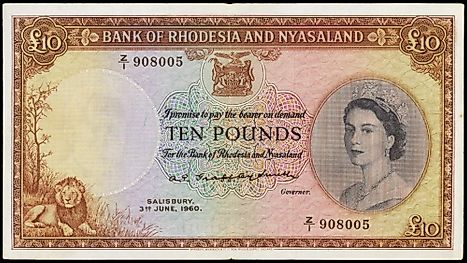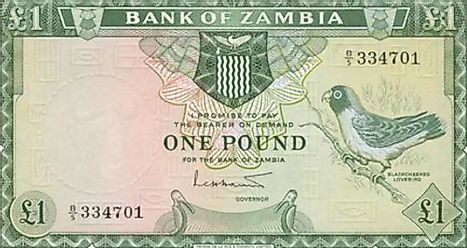Flags, Symbols & Currency of Zambia
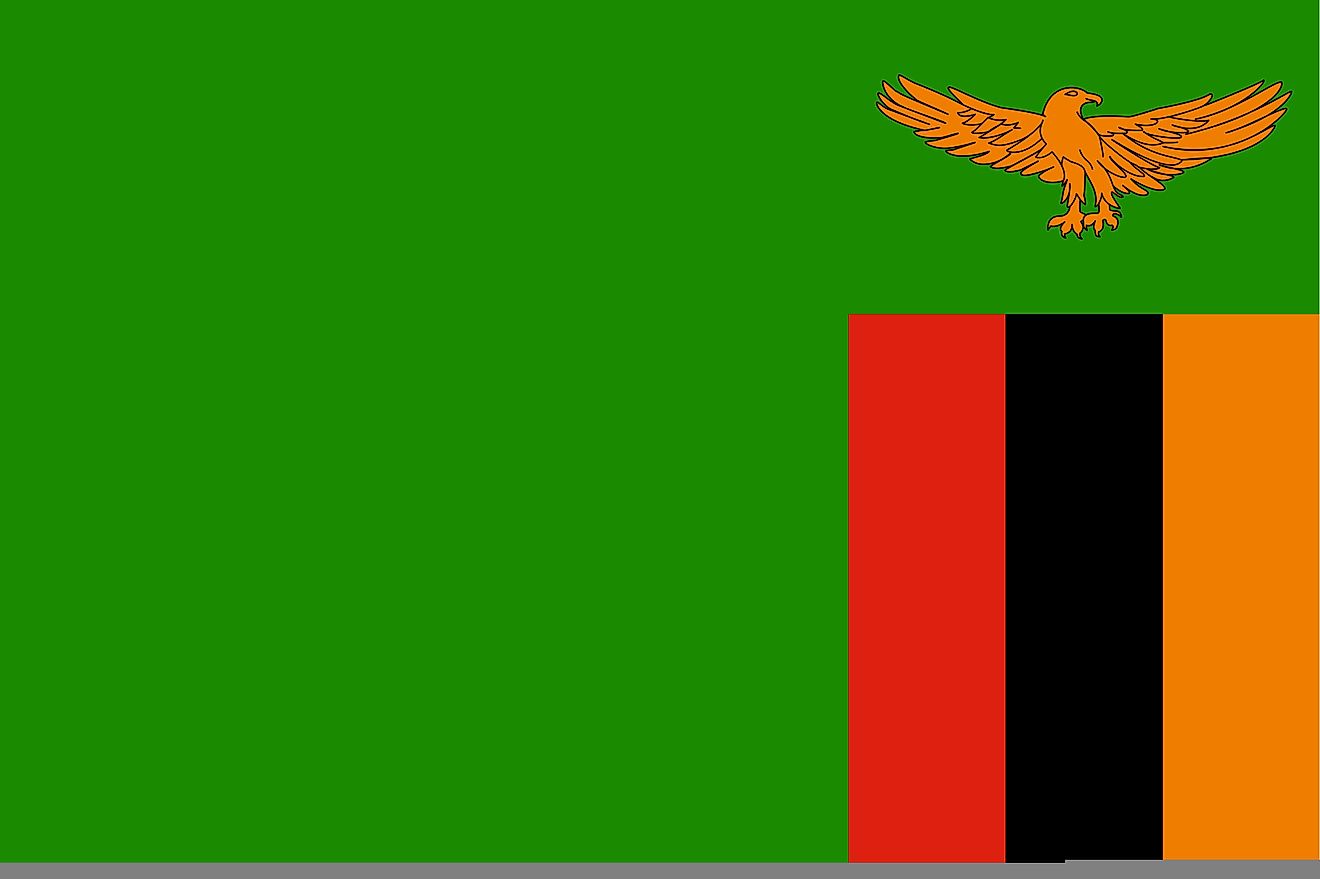
The National Flag of Zambia was officially adopted on October 24, 1964. The flag has been designed by Mrs. Gabriel Ellison - who was head of the Graphics Arts Department in Zambia's Ministry of Information.
The National Flag of Zambia is rectangular and features a green background with a panel of three vertical bands of red (hoist side), black, and orange, below a soaring orange African fish eagle placed on the outer edge of the flag. The green color of the flag symbolizes the country's agricultural wealth and rich vegetation. The red color symbolizes the struggle and bloodshed for freedom from colonial rule. The black color represents the people of Zambia, and the orange color represents the country's natural resources and its mineral wealth (mainly copper). The African fish eagle (Haliaeetus vocifer) flying above the vertical stripes represents the nation’s focus on economic growth and the ability of the people of Zambia to rise above the country's problems. The flag has a height-to-width proportion ratio of 2:3.
History of the Flag of Zambia
In 1890, the first flag to be flown in the area was the flag of the British South Africa Company. In 1953, Southern Rhodesia (now Zimbabwe) merged with Northern Rhodesia (now Zambia), and Nyasaland (now Malawi) to create the Federation of Rhodesia and Nyasaland. Between 1953 and 1963, the federation had a flag, which was a modified version of the British Blue ensign. The fly side of the flag featured the federation's coat of arms on a shield. It had a rising sun taken from the coat of arms of Nyasaland, a lion from the coat of arms of Southern Rhodesia, and black and white wavy lines from the coat of arms of Northern Rhodesia. The flag was used alongside the union jack until December 31, 1963, when the federation was dissolved. Zambia gained independence from the United Kingdom on October 24, 1964, and immediately adopted its current flag. Currently, the national flag of Zambia serves as both the national flag and ensign.
Symbols of Zambia
The National Coat of Arms of Zambia
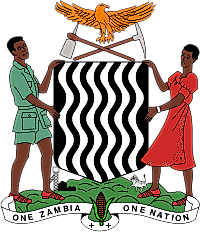
The current official Coat of Arms of Zambia was adopted on October 24, 1964. It is composed of an African Fish Eagle hovering above a pickaxe and hoe. The African Fish Eagle (Haliaeetus vocifer) is the eagle of Liberty and represents the nation’s focus on economic growth and the ability of the people to rise above every problem that is faced by the nation. The pickaxe and hoe represent agriculture and mining – the economic backbone of the nation. Making up the base are a Zambian man and woman supporting a shield. The shield has white waters cascading over a black rock: representing Victoria Falls on the Zambezi River, from which the country gets its name. The Zambian man and woman symbolize the family. The man is seen wearing a bush khaki shirt and shorts that represent the clothes worn by workers before independence. The woman is seen wearing a traditional Zambian dress. The height of both the standing man and woman are the same representing gender equality. Below the shield, the maize cob, the mine-shaft head, and the Zebra are placed on the green color; hence symbolizing agriculture, natural wealth, minerals, and the land. A white ribbon is also placed below the shield, displaying the country's motto: "One Zambia, One Nation”, emphasizing the need to unite the more than 60 different ethnic groups within Zambia.
National Motto
"One Zambia, One Nation"
National Anthem
- Anthem Title: "Stand and Sing of Zambia, Proud and Free"
- Music Composer: Enoch Sontonga
- Lyricists: G. Ellis, E.S. Musonda, J.M.S. Lichilana, I. Lowe, J. Sajiwandani, and R.J. Seal.
- Date of Adoption: September 14, 1973.
"Stand and Sing of Zambia, Proud and Free" is the national anthem of Zambia. The music of the anthem has been composed by Enoch Sontonga. The lyrics of the anthem have been authored by G. Ellis, E.S. Musonda, J.M.S. Lichilana, I. Lowe, J. Sajiwandani, and R.J. Seal. The national anthem was officially adopted on September 14, 1973.
Lumbanyeni Zambia (Bemba)
First Verse:
Lumbanyeni Zambia, no kwanga,
Ne cilumba twange tuumfwane,
Mpalume sha bulwi bwa cine,
Twaliilubula.
Twikatane bonse.
Chorus:
Lumbanyeni,
Lesa, Lesa, wesu,
Apale calo,
Zambia, Zambia, Zambia.
Fwe bantungwa
Mu luunga lwa calo.
Lumbanyeni Zambia.
Twikatane bonse.
Second Verse:
Bonse tuli bana ba Africa,
Uwasenaminwa na Lesa,
Nomba bonse twendele pamo,
Twaliilubula.
Twikatane bonse.
Third Verse:
Fwe lukuta lwa Zambia lonse,
Twikatane tubyo mutende,
Pamo nga lubambe mu mulu,
Lumbanyeni Zambia.
Twikatane bonse.
Stand and Sing of Zambia, Proud and Free
First Verse:
Stand and sing of Zambia, proud and free,
Land of work and joy in unity,
Victors in the struggle for our rights,
We've won freedom's fight.
All one, Strong and Free.
Chorus:
Praise be to God,
Praise be, praise be, praise be,
Bless our great nation,
Zambia, Zambia, Zambia.
Free men we stand
Under the flag of our land.
Zambia, praise to thee!
All one, Strong and Free.
Second Verse:
Africa is our own motherland,
Fashion'd with and blessed by God's good hand,
Let us all her people join as one,
Brothers under the sun.
All one, Strong and Free.
Third Verse:
One land and one nation is our cry,
Dignity and peace 'neath Zambia's sky,
Like our noble eagle in its flight,
Zambia, praise to thee.
All one, Strong and Free.
The Currency of Zambia is the Zambian kwacha
The current official currency of Zambia is the Zambian Kwacha. One Kwacha is subdivided into 100 Ngwee. The Bank of Zambia is mandated to issue and circulate the Zambian currency.
The currency names: Kwacha and Ngwee are derived from the words which mean ‘dawn’ and ‘bright’ in the local languages of Zambia. The terms thus symbolize the freedom of the country from the oppressive colonial rule of the Europeans.
Coins
Currently, coins in denominations of K1, 50N, 10N, and 5N are in circulation.
Banknotes
Currently, K100, K50, K20, K10, K5, K2 banknotes are in circulation. The observe of all 6 banknotes feature the Zambian coat of arms, a unique indigenous tree, and an African fish eagle (Haliaeetus vocifer) - the national bird of Zambia, as well as Namibia, Zimbabwe, and South Sudan. The reverse of each of the 6 banknotes features a unique image of Zambian life, the Freedom Statue, as well as a Zambian animal. The 2-kwacha note features women in a market place as well as a roan antelope. The 5-kwacha note features a cassava plant and tuber, as well as a lion. The 10-kwacha note features farmers in a wheat field as well as a porcupine. The 20-kwacha note features miners in a copper mine as well as a black lechwe. The 50-kwacha note features the bank of Zambia headquarters as well as a leopard. Finally, the 100-kwacha note features the National Assembly Building as well as an African buffalo.
Historical Currencies of Zambia
Before Zambia’s independence from British rule in 1964, banknotes and coins issued by the Central Africa Currency Board were used in the region. The currency was known as the Rhodesia and Nyasaland pound. Following independence, the new currency of the country, the Zambian pound was launched. The coins and banknotes of this currency maintained the previously used denominations except for the 10 pounds note. For a while, the previous currency and the new one were allowed to circulate in parallel. However, in 1965, most of the previous currency’s notes and coins were withdrawn from circulation. The decimalization of the currency was introduced by the government of Zambia in 1966. The same year, the new currency unit of kwacha was launched. One kwacha was equal to 100 Ngwe and one half of a Zambian pound. Within two years, by January 1968, the kwacha and Ngwe became well-established and the coins and banknotes of the Zambian pound were no longer in circulation. By 1974, the old currency ceased to be a legal tender.
The design of the Zambian kwacha underwent several changes over time since its first introduction. The different bills of the currency were also introduced and withdrawn over the years. The first kwacha was released through seven different emissions while the second one was released only once. Currently, the second kwacha that was released on the first of January, 2013, is still in circulation in the country.

